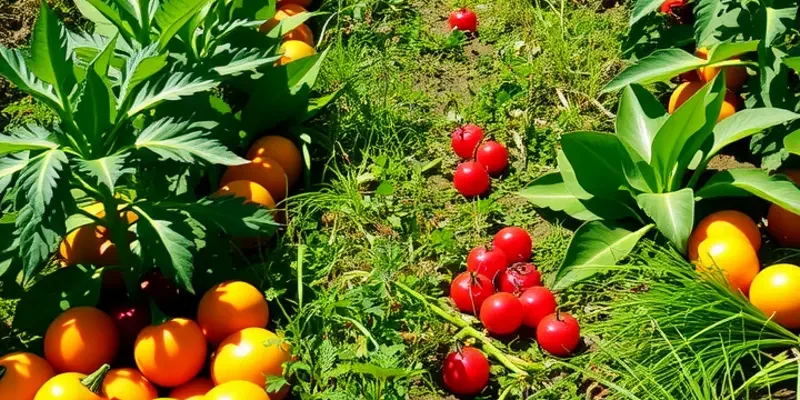Choosing a biodiversity-friendly diet represents a significant step toward preserving our planet’s ecosystem. By selecting foods that promote biodiversity, individuals can make a direct positive impact on the environment. This guide will explore practical ways to adopt a more ecologically conscious diet, emphasizing the importance of diverse food sources, sustainable practices, and supporting local agriculture.
Embracing Diverse Foods for Health and Planet

Incorporating a variety of fruits, vegetables, grains, and legumes into your daily meals is not just a celebration of flavors and textures, but also a vital step toward enhancing health and supporting biodiversity. Diversity in diet contributes to a well-rounded intake of essential nutrients and plays a crucial role in protecting ecosystems and sustaining local agriculture.
A diverse diet is rich in phytonutrients, vitamins, and minerals, ensuring our bodies receive the necessary fuel for optimal functioning. Each food group contributes unique nutrients: fruits and vegetables provide antioxidants and fiber, grains offer essential carbohydrates and minerals, and legumes are a great source of protein and iron. By varying your food choices, you tap into a broader spectrum of these nutritional benefits, promoting better health and longevity.
From an environmental perspective, diversity in agriculture means cultivating multiple crops rather than relying on monocultures. This practice supports soil health, encourages pollinator populations, and reduces the need for chemical fertilizers, which can harm natural ecosystems. Choosing native and heirloom varieties helps preserve genetic diversity among crops, enabling them to adapt to changing environmental conditions. Local and organic farming further enhances this dynamic by reducing carbon footprints and supporting soil vitality.
Creating a diverse diet also means exploring new and perhaps lesser-known food options like ancient grains, which have sustained communities for centuries but are only recently gaining popularity outside their native regions. Amaranth, quinoa, and millet not only add variety to your meals but also support farmers who cultivate these nutritionally dense crops. Legumes like lentils and chickpeas are versatile and sustainable protein sources, requiring less water and fertilizer compared to meat production.
Embracing this diversity at home can be simple. Add a range of colors to your plate by incorporating seasonal produce. Rotate different grains—try buckwheat pancakes one day and a barley salad the next—and explore new recipes that highlight these ingredients. Incorporating traditional practices from different cultures can also inspire your culinary creativity and broaden your palate. For tips on easy plant-based eating, you might find this guide valuable.
Biodiversity on your plate extends beyond just health and planetary benefits. It supports local economies, keeps cultural food traditions alive, and enhances food security by reducing dependency on a limited number of crops. As individuals, every meal is an opportunity to make a positive impact, nurturing both ourselves and the planet by choosing a diverse and environmentally sustainable diet. By cultivating these mindful eating habits, you contribute to a more balanced and resilient world.
Sustainable Sourcing: Local, Seasonal, and Organic

Choosing to fill our plates with local, seasonal, and organic foods is a meaningful step toward reducing environmental impact. By prioritizing these choices, we support farming methods that are kind to the earth while fostering local economies. Eating sustainably is not just an eco-friendly buzzword; it has far-reaching benefits that intertwine with our everyday choices.
Focusing on locally produced food reduces the carbon footprint associated with transportation. When food travels shorter distances, it requires less fuel and fewer emissions. This also means that local produce often reaches consumers fresher and more nutrient-rich. Not to mention, it keeps our hard-earned money circulating within our communities, supporting small-scale farmers and local businesses.
Embracing seasonal produce is another way to promote biodiversity and enjoy natural, flavorsome meals. Seasonal fruits and vegetables grow without the need for artificial heating or energy-intensive greenhouse setups, leading to lower carbon emissions. These crops often require fewer pesticides and fertilizers, aligning with more natural agricultural practices. Engaging with seasonal eating can expand our culinary horizons. It encourages experimenting with different ingredients that might otherwise remain unnoticed on the shelves.
Supporting organic farming practices is a transformative way to improve soil health and reduce chemical runoff into water systems. Organic agriculture typically avoids synthetic herbicides and fertilizers, relying instead on natural processes. This approach enhances the resilience of ecosystems and supports wildlife habitats. Although organic products might come with a premium price tag, they offer long-term ecological benefits.
For those starting their sustainable sourcing journey, finding local and seasonal products can be a rewarding experience. Farmers’ markets are excellent places to connect directly with producers and learn more about the growing process. Community supported agriculture (CSA) programs also offer a way to receive regular, fresh produce directly from local farms. These initiatives often include detailed information about each item’s origin and farming practices.
Supermarkets are increasingly accommodating sustainable choices by tagging local, seasonal, and organic items. Remember, sustainable sourcing doesn’t demand perfection but rather a commitment to incremental change. Educate yourself through blogs and resources dedicated to eco-smart practices, such as eco-smart kitchen storage, which can complement sustainable sourcing with efficient use and storage of your groceries.
Whether it’s the vibrancy of spring asparagus, the sweetness of summer berries, or the warmth of autumn squash, each season offers unique flavors. By aligning our choices with natural cycles, we not only become more mindful eaters but also champions of biodiversity. While the journey to sustainability can be daunting, each choice to consume local, seasonal, and organic is a step toward preserving the planet for future generations.
Final words
Embracing a biodiversity-friendly diet is an attainable goal that yields significant benefits for both individual health and the environment. By prioritizing a diverse array of foods, sourcing locally and seasonally, and supporting sustainable practices, everyone can contribute to the preservation of our planet’s rich biodiversity. Begin today by making small, incremental changes to your grocery list and meal planning—each sustainable choice contributes to a healthier ecosystem.








